英国议会制辩论赛规则(BP-Debate)
BP Debate
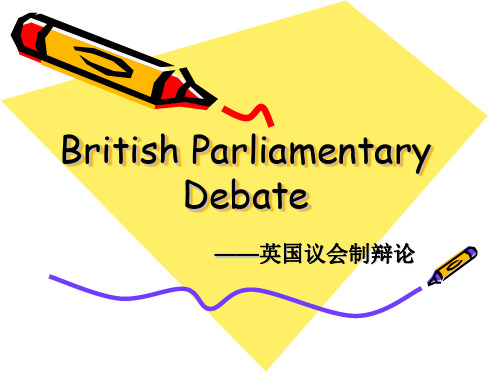
Speaker 1st Proposition Team, 1st speaker 1st Opposition Team, 1st speaker 1st Proposition Team, 2nd speaker 1st Opposition Team, 2nd speaker
Common Titles for Speaker "Prime Minister" or "First Government Member” "Leader of the Opposition" or "First Opposition member" "Deputy Prime Minister" or "Second Government member" "Deputy Leader of the Opposition" or "Second Opposition member" 7
7. “Proposition Whip" 8. "Opposition Whip"
• Refutation • Summarize the extension of your team • Should not introduce new opintion(POI)
5. "Member of the Proposition“ 6. "Member of the Opposition"
• Support the case developed by the first proposition team • Refutation • Extension: new enough, good analysis
bp英语辩论正方一辩发言稿模板

bp英语辩论正方一辩发言稿模板English Response:---。
English Response:Certainly! Here's a template for the first affirmative speaker in a British Parliamentary (BP) style debate:Introduction:Start with a captivating hook or a relevant quote to grab the audience's attention.Introduce the motion and provide a clear definition if necessary.State your team's stance and briefly outline your main arguments.Main Arguments:1. Argument 1:Present your first argument clearly and concisely.Provide evidence or examples to support your point.Anticipate and refute potential counterarguments.2. Argument 2:Introduce your second argument, building upon the first one.Use statistics, anecdotes, or expert opinions to strengthen your argument.Address any weaknesses or limitations in your argument.3. Argument 3:Introduce your third argument, ensuring it complements the previous ones.Utilize logic and reasoning to persuade the audience.Summarize the key points of your argument for emphasis.Rebuttals:Briefly address any points made by the opposing team.Refute their arguments using logic, evidence, or counterexamples.Reinforce your team's position while weakening the opposition's arguments.Conclusion:Summarize your main arguments and restate your team's stance.Leave a memorable closing statement or call to action.English Response:---。
国才杯辩论赛规则(3篇)
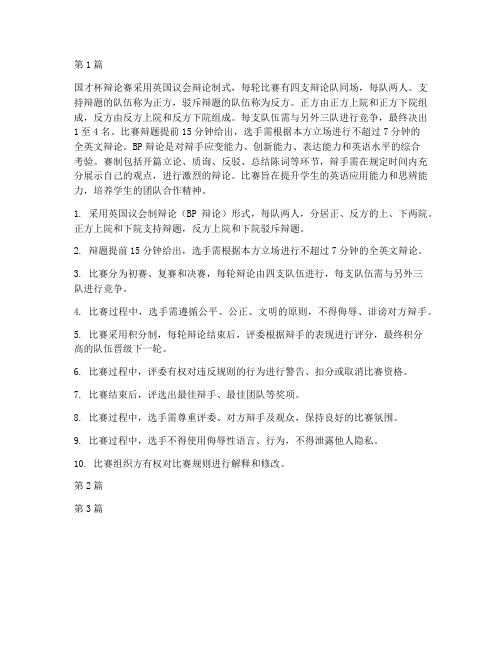
第1篇国才杯辩论赛采用英国议会辩论制式,每轮比赛有四支辩论队同场,每队两人。
支持辩题的队伍称为正方,驳斥辩题的队伍称为反方。
正方由正方上院和正方下院组成,反方由反方上院和反方下院组成。
每支队伍需与另外三队进行竞争,最终决出1至4名。
比赛辩题提前15分钟给出,选手需根据本方立场进行不超过7分钟的全英文辩论。
BP辩论是对辩手应变能力、创新能力、表达能力和英语水平的综合考验。
赛制包括开篇立论、质询、反驳、总结陈词等环节,辩手需在规定时间内充分展示自己的观点,进行激烈的辩论。
比赛旨在提升学生的英语应用能力和思辨能力,培养学生的团队合作精神。
1. 采用英国议会制辩论(BP辩论)形式,每队两人,分居正、反方的上、下两院。
正方上院和下院支持辩题,反方上院和下院驳斥辩题。
2. 辩题提前15分钟给出,选手需根据本方立场进行不超过7分钟的全英文辩论。
3. 比赛分为初赛、复赛和决赛,每轮辩论由四支队伍进行,每支队伍需与另外三队进行竞争。
4. 比赛过程中,选手需遵循公平、公正、文明的原则,不得侮辱、诽谤对方辩手。
5. 比赛采用积分制,每轮辩论结束后,评委根据辩手的表现进行评分,最终积分高的队伍晋级下一轮。
6. 比赛过程中,评委有权对违反规则的行为进行警告、扣分或取消比赛资格。
7. 比赛结束后,评选出最佳辩手、最佳团队等奖项。
8. 比赛过程中,选手需尊重评委、对方辩手及观众,保持良好的比赛氛围。
9. 比赛过程中,选手不得使用侮辱性语言、行为,不得泄露他人隐私。
10. 比赛组织方有权对比赛规则进行解释和修改。
第2篇第3篇。
BP Debate英国议会辩论制介绍
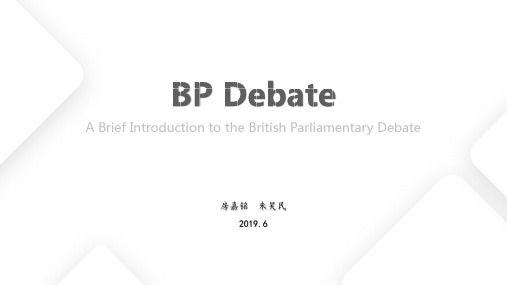
7 minutes
Leader of Opposition
1st Opposition
7 minutes
Deputy Prime Minister
1st Government
7 minutes
Deputy Leader of Opposition
1st Opposition
7 minutes
Lower House (Second Half of the Debate)
interpreted it.
➢ Refutes the arguments presented by the Leader of Opoosition. ➢ Rebuilds the case presented by the Prime Minister. ➢ Constructs one or more new arguments supporting the case of the Prime
➢ Summarizes the entire debate from the point of view of the Government, defending the general viewpoint of both Government Teams, with a special eye toward the case of the Second Government Team. This overall summary may include a defense of the Member of Government's extension.
➢ Defines and interprets the motion. ➢ Describes the approach the First Government Team will take. ➢ Constructs the case for that interpretation of the motion.
最新英国议会辩论制介绍
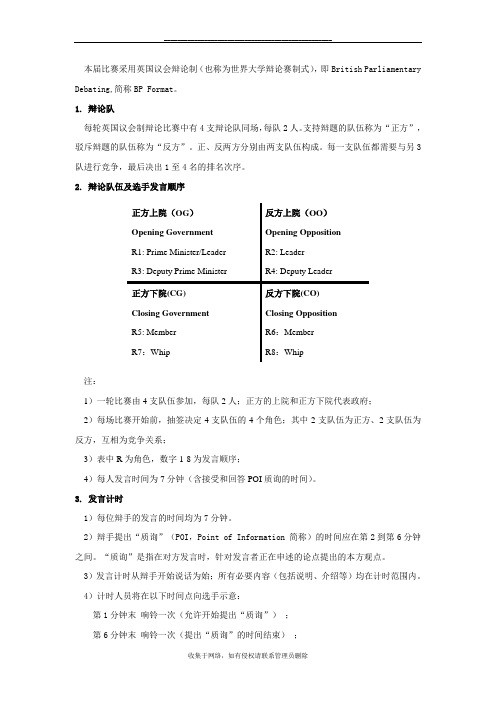
本届比赛采用英国议会辩论制(也称为世界大学辩论赛制式),即British Parliamentary Debating,简称BP Format 。
1. 辩论队每轮英国议会制辩论比赛中有4支辩论队同场,每队2人。
支持辩题的队伍称为“正方”,驳斥辩题的队伍称为“反方”。
正、反两方分别由两支队伍构成。
每一支队伍都需要与另3队进行竞争,最后决出1至4名的排名次序。
2. 辩论队伍及选手发言顺序 注:1)一轮比赛由4支队伍参加,每队2人;正方的上院和正方下院代表政府;2)每场比赛开始前,抽签决定4支队伍的4个角色;其中2支队伍为正方、2支队伍为反方,互相为竞争关系;3)表中R 为角色,数字1-8为发言顺序;4)每人发言时间为7分钟(含接受和回答POI 质询的时间)。
3. 发言计时1)每位辩手的发言的时间均为7分钟。
2)辩手提出“质询”(POI ,Point of Information 简称)的时间应在第2到第6分钟之间。
“质询”是指在对方发言时,针对发言者正在申述的论点提出的本方观点。
3)发言计时从辩手开始说话为始;所有必要内容(包括说明、介绍等)均在计时范围内。
4)计时人员将在以下时间点向选手示意:第1分钟末 响铃一次(允许开始提出“质询”) ; 第6分钟末 响铃一次(提出“质询”的时间结束) ;正方上院(OG ) Opening Government R1: Prime Minister/Leader R3: Deputy Prime Minister 反方上院(OO ) Opening Opposition R2: Leader R4: Deputy Leader 正方下院(CG) Closing Government R5: Member R7:Whip反方下院(CO) Closing Opposition R6:Member R8:Whip第7分钟末连续响铃两次(发言时间结束);7分15秒连续响铃(发言缓冲时间结束)。
IntroductionToBPDebate双语版

Your speeches will be timed by a timekeeper or by the judge由计时员或裁判计时
Speaker Roles and Responsibilities
-- Provides more specific refutation of 2nd proposition具体性反驳对方下院
-- Provides new opposition extension.扩展
Lower House 下院
7th Speaker – Government Whip
第七发言者——政府党鞭
LO
DPM
DLO
MG
MO
GW
OW
Lower House (Closing)
辩手称谓
上院(上半场)
首相 反对党领袖 副首相 反对党副领袖
下院 (下半场)
政府阁员 反对党阁员 政府党鞭 反对党党鞭
首相
上院 (上半场)
反对党领袖
副首相
反对党副领袖
政府阁员
反对党阁员
政府党鞭
反对党党鞭
NO POI --- protected time (the first and the last minute); Time --- 15 seconds or less
信息点(质询)
POI --- 信息点(质询) 谁来质询 --- 陈词者对方的任一辩手; 质询内容 --- 评论, 陈述, 提问…; 怎么质询 --- 举手示意 或者说 “质询”
--- Summarizes the entire debate from the point of view of the proposition从正方立场 角度总结全场
英国议会制辩论赛规则(BP-Debate)
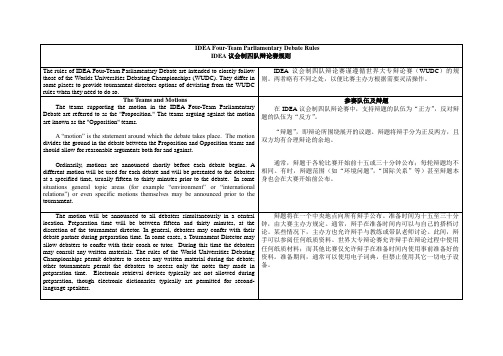
反方二队,一辩
反对党成员"Member for the Opposition"
7分钟
正方二队,二辩
内阁党鞭陈词"Government Whip"
7分钟
反方二队,二辩
反对党党鞭陈词"Opposition Whip"
7分钟
Parliamentary Points of Information
Debaters may offer a point of information (either verbally or by rising) at any time after the first minute, and before the last minute, of any speech. The debater holding the floor may accept or refuse points of information. If accepted, the debater making the request has fifteen seconds present the point of information. During the point of information, the speaking time of the floor debater continues.
A “motion” is the statement around which the debate takes place. The motion divides the ground in the debate between the Proposition and Opposition teams and should allow for reasonable arguments both for and against.
英国议会制辩论赛制度
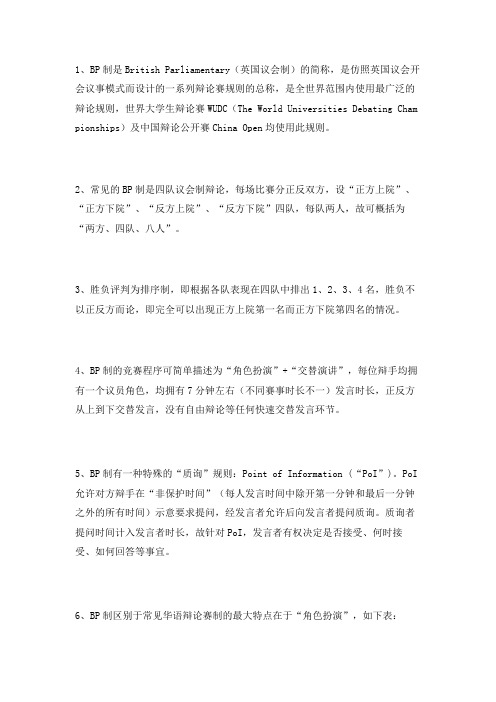
1、BP制是British Parliamentary(英国议会制)的简称,是仿照英国议会开会议事模式而设计的一系列辩论赛规则的总称,是全世界范围内使用最广泛的辩论规则,世界大学生辩论赛WUDC(The World Universities Debating Cham pionships)及中国辩论公开赛China Open均使用此规则。
2、常见的BP制是四队议会制辩论,每场比赛分正反双方,设“正方上院”、“正方下院”、“反方上院”、“反方下院”四队,每队两人,故可概括为“两方、四队、八人”。
3、胜负评判为排序制,即根据各队表现在四队中排出1、2、3、4名,胜负不以正反方而论,即完全可以出现正方上院第一名而正方下院第四名的情况。
4、BP制的竞赛程序可简单描述为“角色扮演”+“交替演讲”,每位辩手均拥有一个议员角色,均拥有7分钟左右(不同赛事时长不一)发言时长,正反方从上到下交替发言,没有自由辩论等任何快速交替发言环节。
5、BP制有一种特殊的“质询”规则:Point of Information (“PoI”)。
PoI 允许对方辩手在“非保护时间”(每人发言时间中除开第一分钟和最后一分钟之外的所有时间)示意要求提问,经发言者允许后向发言者提问质询。
质询者提问时间计入发言者时长,故针对PoI,发言者有权决定是否接受、何时接受、如何回答等事宜。
6、BP制区别于常见华语辩论赛制的最大特点在于“角色扮演”,如下表:正方上院第一位发言者首相(Prime Minister)正方一辩反方上院第一位发言者反对党领袖(Leader of the Opposition)反方一辩正方上院第二位发言者副首相(Deputy Prime Minister)正方二辩反方上院第二位发言者反对党副领袖(Deputy Leader of the O pposition)反方二辩正方下院第一位发言者政府阁员(Member of Government)正方三辩反方下院第一位发言者反对党阁员(Member of the Opposition)反方三辩正方下院第二位发言者政府党鞭(Government Whip)正方四辩反方下院第二位发言者反对党党鞭(Opposition Whip)反方四辩7、除一般的“立我方、批对方”的发言责任外,BP制中每个角色还有其独特的角色责任,对该责任的实现程度构成胜负评判的最大因素。
BP辩论赛赛制介绍

∙General rules1. IntroductionThe “FLTRP CUP” National English Debating Competition(hereafter referred to as “the Competition”) inaugurated in 1997 is the onlynational English debating event in ... ∙General rules1. IntroductionThe “FLTRP CUP” Nationa l English Debating Competition(hereafter referred to as “the Competition”) inaugurated in 1997 is the onlynational English debating event in China. The FLTRP CUP National EnglishDebating Competition is jointly hosted by the Foreign Language Teaching andResearch Press Cambridge University Press and the International Debate EducationAssociation (IDEA) coordinated by the China English Language EducationAssociation (CELEA) English Speaking Union (ESU) English Language Learningmagazine (ELL) and sponsored by CASIO (Shanghai).2. Competition FormatThe Competition shall be conducted in the BritishParliamentary Debating Style (also known as the World Universities DebatingChampionships Style) as defined in Part 2.3. Required qualificationsfor the competitionA debater must be a registeredfull-time undergraduate of Chinese nationality in a Chinese territoryeducational institution. Those who have wonoverseas awards of the past CCTV CUP English Speaking Contest or past FLTRP CUPNational English Debating Competition are excluded from participating in theFLTRP Cup.The British Parliamentary format1. The TeamsFour teams of two debaters participate in each British Parliamentarydebate round. The teams supporting themotion are referred to as the "Proposition." The teams arguingagainst the motion are known as the "Opposition" teams. Two teams represent the Proposition: theOpening Proposition and the Closing Proposition. Two teams represent the Opposition: theOpening Opposition and the Closing Opposition. Each of these teams competes against all other teams in the round andwill be ranked 1st through 4th at the conclusion of thedebate.Opening PropositionOpening OppositionClosing PropositionClosing Opposition2. Speaker OrderEach speaker will present a single speech in the order prescribedbelow. SpeakerCommon Titles for SpeakerTimeOpening Proposition Team 1st speaker"Prime Minister" or “Leader of the Proposition”7 minutesOpening Opposition Team 1st speaker"Leader of the Opposition"7 minutesOpening Proposition Team 2nd speaker"Deputy Prime Minister" or "Deputy Leader of the Proposition"7 minutesOpening Opposition Team 2nd speaker"Deputy Leader of the Opposition"7 minutesClosing Proposition Team 1st speaker"Member of the Proposition" "7 minutesClosing Opposition Team 1st speaker"Member of the Opposition"7 minutesClosing Proposition Team 2nd speaker"Proposition Whip"7 minutesClosing Opposition Team 2nd speaker"Opposition Whip"7 minutes3. Speech timingEach speech will be 7 minutes. Points of Information are allowed after the first minute and before thelast minute of all speeches.Timing of the speech begins whenthe speaker begins speaking; all material—including acknowledgementsintroductions etc.—will be timed. Atimekeeper will provide a series of signals during each speech as follows:∙ TimingSignal1:00Single ring of a bell (POIs allowed)6:00Single ring of a bell (POIs no longer allowed)7:00Double ring of a bell (Conclusion of speaking time)7:15Continuous ringing (Conclusion of ...∙ TimingSignal1:00Single ring of a bell (POIs allowed)6:00Single ring of a bell (POIs no longer allowed)7:00Double ring of a bell (Conclusion of speaking time)7:15Continuous ringing (Conclusion of grace period)Once the double ring has sounded speakers have a 15-second ‘grace period’ during which th ey should conclude their remarks. The grace period is not a time for new matter to be introduced and any new matter offered in the grace period may be discounted by the adjudicators. Speakers continuing after this ‘grace period’ may be penalized by the adjudication panel.4.Speaker RolesEach speaker has a role and each speech has a specific purpose. The descriptions of speaker roles listed below are suggestive and are not intended to be exhaustive or exclusive. For reasons that vary from debate to debate speakers may sometimes need to fulfill roles not mentioned here and speeches may be constructed to serve other purposes as long as Proposition speakers affirm the motion and Opposition speakers oppose it.All speakers except the final speakers for the Proposition and Opposition (Proposition and Opposition Whips) should introduce new material. All debaters should refute the opposing teams’ arguments except the Prime Minister.SpeakerRole and Responsibility"Prime Minister" or "Leader of the Proposition”The first speaker's responsibility is to present a case supporting the motion. The primary role of Opening Proposition team initiated in this speech is to establish the foundation for meaningful debate on the motion.“Leader of the Opposition"The Opening Opposition's primary team role is to counter the first Proposition team's case through direct or indirect refutation and/or provide substantive arguments against the motion."Deputy Prime Minister"This speaker should refute the Leader of the Opposition's speech and further develop the Opening Proposition team's case."Deputy Leader of the Opposition"This speaker supports his or her teammate answering objections from the other side and introducing additional arguments or support."Member of the Proposition"This speaker should support the position developed by the Opening Proposition team by introducing an extension. A successful extension will develop a distinct argument identity for the Closing Proposition team while supporting the Opening Proposition team. The Member of the Proposition may also refute the arguments made by the Deputy Leader of the Opposition."Member of the Opposition"This speaker should support the position developed by the Opening Opposition team and must also introduce an extension. As with the Member Proposition the Member Opposition’s extension will be most successful if it establishes a unique argument identity that distinguishes the Closing from the Opening Opposition while continuing the general direction of argument initiated by the Opening Opposition. The Member Opposition may also directly or indirectly refute the arguments of the Member Proposition.∙"Proposition Whip"This speaker summarizes the Proposition’s arguments and summarizes the refutation of the Opposition side. With the exception of refuting the Member Opposition’s extension the ...∙ "Proposition Whip"This speaker summarizes the Propos ition’s arguments and summarizes the refutation of the Opposition side. With the exception of refuting the Member Opposition’s extension the speaker should not introduce positive (new) matter."Opposition Whip"This speaker summarizes opposition to the extension and makes reply to each team's position in the debate. This speaker should not introduce positive (new) matter.5.The MotionsA single motion will be announced thirty minutes prior to the beginning of the debate and will be presented to all debaters simultaneously in a general assembly. A different motion will be used for each round.Motions typically focus on current issues or timeless controversies and are phrased in a way that is intended to be specific and unambiguous.6.Focus and content of debatesBritish Parliamentary debating is a contest of ideas in which the Proposition teams are responsible for providing reasons why the motion is true and the Opposition teams are responsible for providing reasons why the motion is not true or why the Proposition has failed to prove the motion true. All teams have a responsibility to refute either directly or indirectly arguments presented by the opposing side.Motions are written in plain language. The debaters—particularly the Opening Proposition team—should respect the meaning and focus of the motion. While the Opening Proposition team may clarify the meaning of terms in the motion they should not attempt to alter the meaning of the motion. The Leader of the Proposition should provide any clarification of terms at the beginning of his or her speech.In the majority of cases the clarification provided by the Opening Proposition team will serve as an adequate foundation for the rest of the debate. Should the Opening Proposition fail to make clear the focus of the debate or if the interpretation offered by the Opening Proposition team completely inhibits meaningful debate or completely misinterprets the meaning the motion the Opening Opposition may offer clarification of the terms of the motion. No teams beyond the Opening Proposition and Opening Opposition may substantially modify the terms of the motion.7.PreparationAll debates shall commence 30 minutes after the motion has been announced. Debaters may consult any written materials during the preparation time. Except for the designated CASIO electronic dictionary no access to other electronic media or electronic storage or retrieval devices is permittedafter motions have been released. Printed and prepared materials may be accessed during a debate.Debaters may confer with their debate partner during preparation time. Debaters may also confer with one tutor from their university during the preparation time.Debaters may not confer with any other individuals (i.e.: coaches other debaters trainers adjudicators etc.) during the preparation time.The Opening Proposition shall have the right to prepare in the debating venue. All other teams must prepare in separate locations.∙ Teams must arrive at their chamber within five minutes of the time of commencement of debate. Teams failing to arrive in time will forfeit the debate at the discretion of the Chair of the panel.8 ...∙ Teams must arrive at their chamber within five minutes of the time of commencement of debate. Teams failing to arrive in time will forfeit the debate at the discretion of the Chair of the panel.8.Points of InformationDebaters may request a point of information (either verbally or by rising) at any time after the first minute and before the last minute of any speech.The debater holding the floor may accept or refuse any points of information within this time. If accepted the debater making the request has fifteen seconds to make a statement or ask a question. During the point of information the speaking time of the floor debater continues. Management of Points of Information—for both the debaters offering and answering Points of Information—will be considered in the adjudicators’ ranking of teams and assignment of individual speaker points.No other parliamentary points such as points of order or points of personal privilege are allowed.Competition Administration1.Structure of the competitionThe Competition shall be run in two main phases: phase one known as the ‘Preliminary’ rounds and phase two known as the ‘Elimination’ rounds. There shall be one mock round eight Preliminary rounds and fourElimination rounds. All teams entered in the Competition shall participate in the Preliminary rounds. Only the top 32 teams will participate in the Elimination rounds.2.The Mock RoundThe mock round will be held as part of the training for the FLTRP Cup. The pairing of the mock round will be random and the results of the mock round will not count for the Preliminary or Elimination rounds.3.Pairing the Preliminary RoundsIf the total number of teams entered in the Competition is not divisible by four or during the Competition the withdrawal of teams results in a total number of teams not divisible by four the tournament administrators shall employ “swing teams” to fill vacant slots. The swing teams shall be ranked in each round relative to the teams against whom they compete (i.e.: if a swing team is the best team in a round they should be ranked 1st) but will be ineligible to advance to the Elimination rounds.The first round of the Competition will be paired randomly.At the conclusion of each preliminary round (except for the last round) teams shall be ranked in order of their aggregate team points accumulated by the team; from highest aggregate to lowest.The teams should then be divided up into pools of teams with the same amount of aggregate team points with pools being ranked from highest aggregate to lowest.If any pool (the “Upper Pool”) consists of an amount of teams equivalent to a number that is not divisible by four then teams from the pool ranking immediately below that pool (the “Lower Pool”) may be promoted to the Upper Pool so that the Upper Pool consists of a number of teams that is divisible by four. The team selected for promotion must be selected randomly from the Lower Pool. If promotion of a team to the Upper Pool results in a number of teams in the Lower Pool not divisible by four each consecutive pool should be adjusted in the same fashion until all pools have a number of teams divisible by four.Once the pools have been adjusted the pools are paired into debates of four teams in such a way that equalizes the team positions in which each team will debate. The pairing should promote to th ...Once the pools have been adjusted the pools are paired into debates of four teams in such a way that equalizes the team positions in which each team will debate. The pairing should promote to the greatest extent possible equality of distribution of team positions over the Preliminary rounds.Preliminary rounds 1-6 shall be “open adjudication” with oral adjudications given by the adjudication panel following each debate. Preliminary rounds 7 & 8 shall be “closed” with no oral adjudication (including any disclosure of the results of the round) permitted.3.Selection of teams for the Elimination RoundsAt the conclusion of the Preliminary rounds the teams shall be ranked in order according to 1) their aggregate team points from the eight preliminary rounds; 2) their aggregate team scores as determined by combining the individual speaker scores for each team member; 3)head-to-head matches between two teams tied for a rank; and 4) preponderance of first place rankings. If after these tie-breakers are applied a tie still exists the rankings of the tied teams shall be determined by drawing lots. The top thirty-two (32) teams ranked by this method shall be selected to compete in the Elimination rounds.4.Pairing of Elimination RoundsThere shall be four elimination rounds: Octofinals Quarterfinals Semifinals and Finals. Each Elimination round shall be paired by “folding” the bracket of the top 32 teams as determined by their aggregate team points. For example the first Octofinal round would be comprised of the teams ranked 1st 16th 17th and 32nd. The second Quarterfinal round would be comprised of the teams ranked 2nd 15th 18th and 31st and so on.5.Advancement of teams through elimination roundsAt the conclusion of each Elimination round debate (with the exception of the Final round) the adjudication panel shall select two of the four teams to advance to the next Elimination round. Those teams assume the highest rankings available in their room (i.e.: for the purposes of ranking the two teams to emerge from the first Octofinal round will be ranked 1st and 16th regardless of their ranking prior to the Octofinal round).For the Final round the adjudication panel shall select one Championship team. All other teams in the Final round will be designated “Finalists.”6.Access to debatesIn preliminary rounds observers may watch a debate round with the consent of the teams participating in the round. Similarly those interested in photographing or recording video of the preliminary rounds must obtain the consent of the debaters participating in the round.Elimination rounds are open to all observers subject to the。
外研社英语辩论赛规则(3篇)
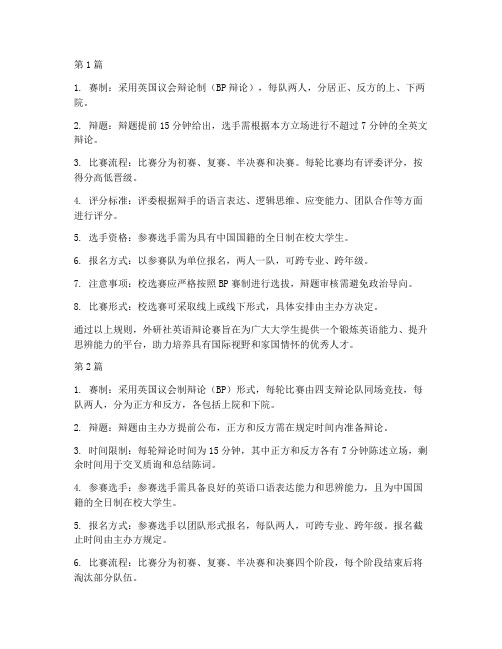
第1篇1. 赛制:采用英国议会辩论制(BP辩论),每队两人,分居正、反方的上、下两院。
2. 辩题:辩题提前15分钟给出,选手需根据本方立场进行不超过7分钟的全英文辩论。
3. 比赛流程:比赛分为初赛、复赛、半决赛和决赛。
每轮比赛均有评委评分,按得分高低晋级。
4. 评分标准:评委根据辩手的语言表达、逻辑思维、应变能力、团队合作等方面进行评分。
5. 选手资格:参赛选手需为具有中国国籍的全日制在校大学生。
6. 报名方式:以参赛队为单位报名,两人一队,可跨专业、跨年级。
7. 注意事项:校选赛应严格按照BP赛制进行选拔,辩题审核需避免政治导向。
8. 比赛形式:校选赛可采取线上或线下形式,具体安排由主办方决定。
通过以上规则,外研社英语辩论赛旨在为广大大学生提供一个锻炼英语能力、提升思辨能力的平台,助力培养具有国际视野和家国情怀的优秀人才。
第2篇1. 赛制:采用英国议会制辩论(BP)形式,每轮比赛由四支辩论队同场竞技,每队两人,分为正方和反方,各包括上院和下院。
2. 辩题:辩题由主办方提前公布,正方和反方需在规定时间内准备辩论。
3. 时间限制:每轮辩论时间为15分钟,其中正方和反方各有7分钟陈述立场,剩余时间用于交叉质询和总结陈词。
4. 参赛选手:参赛选手需具备良好的英语口语表达能力和思辨能力,且为中国国籍的全日制在校大学生。
5. 报名方式:参赛选手以团队形式报名,每队两人,可跨专业、跨年级。
报名截止时间由主办方规定。
6. 比赛流程:比赛分为初赛、复赛、半决赛和决赛四个阶段,每个阶段结束后将淘汰部分队伍。
7. 评分标准:评委根据选手的辩论技巧、语言表达、逻辑思维等方面进行评分,最终评选出优胜者。
8. 注意事项:参赛选手需遵守比赛规则,尊重评委和对手,维护比赛秩序。
总之,外研社英语辩论赛旨在为广大大学生提供一个展示英语口语能力和思辨能力的平台,激发他们的学习热情,提升综合素质。
第3篇1. 参赛对象:面向全国高校学生,分为本科组和高职组。
BP英国议会制辩论资料
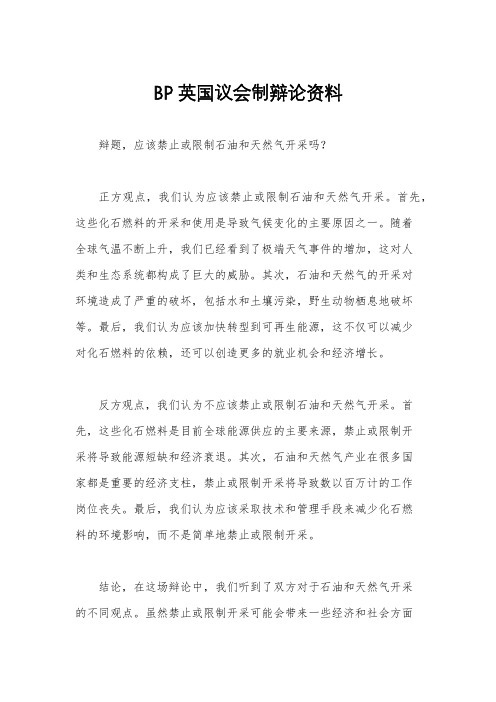
BP英国议会制辩论资料
辩题,应该禁止或限制石油和天然气开采吗?
正方观点,我们认为应该禁止或限制石油和天然气开采。
首先,这些化石燃料的开采和使用是导致气候变化的主要原因之一。
随着
全球气温不断上升,我们已经看到了极端天气事件的增加,这对人
类和生态系统都构成了巨大的威胁。
其次,石油和天然气的开采对
环境造成了严重的破坏,包括水和土壤污染,野生动物栖息地破坏等。
最后,我们认为应该加快转型到可再生能源,这不仅可以减少
对化石燃料的依赖,还可以创造更多的就业机会和经济增长。
反方观点,我们认为不应该禁止或限制石油和天然气开采。
首先,这些化石燃料是目前全球能源供应的主要来源,禁止或限制开
采将导致能源短缺和经济衰退。
其次,石油和天然气产业在很多国
家都是重要的经济支柱,禁止或限制开采将导致数以百万计的工作
岗位丧失。
最后,我们认为应该采取技术和管理手段来减少化石燃
料的环境影响,而不是简单地禁止或限制开采。
结论,在这场辩论中,我们听到了双方对于石油和天然气开采
的不同观点。
虽然禁止或限制开采可能会带来一些经济和社会方面
的困难,但我们也不能忽视化石燃料对气候和环境的影响。
我们希望政府和企业能够在保障能源供应的同时,加大对可再生能源的投资,推动能源转型,实现可持续发展。
bp赛制
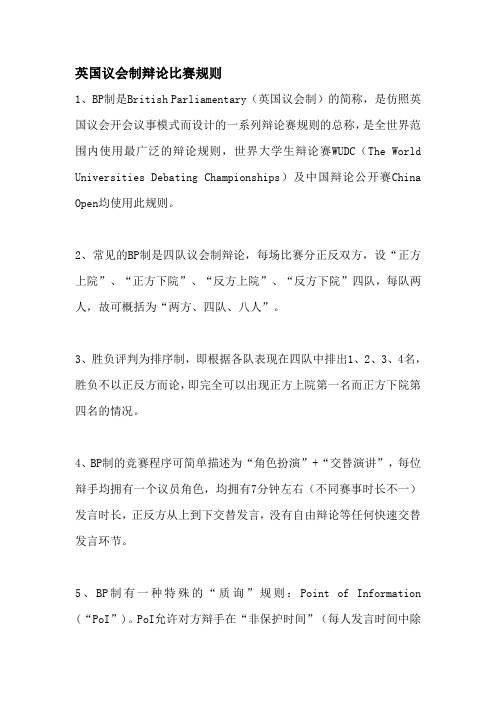
英国议会制辩论比赛规则1、BP制是British Parliamentary(英国议会制)的简称,是仿照英国议会开会议事模式而设计的一系列辩论赛规则的总称,是全世界范围内使用最广泛的辩论规则,世界大学生辩论赛WUDC(The World Universities Debating Championships)及中国辩论公开赛China Open均使用此规则。
2、常见的BP制是四队议会制辩论,每场比赛分正反双方,设“正方上院”、“正方下院”、“反方上院”、“反方下院”四队,每队两人,故可概括为“两方、四队、八人”。
3、胜负评判为排序制,即根据各队表现在四队中排出1、2、3、4名,胜负不以正反方而论,即完全可以出现正方上院第一名而正方下院第四名的情况。
4、BP制的竞赛程序可简单描述为“角色扮演”+“交替演讲”,每位辩手均拥有一个议员角色,均拥有7分钟左右(不同赛事时长不一)发言时长,正反方从上到下交替发言,没有自由辩论等任何快速交替发言环节。
5、BP制有一种特殊的“质询”规则:Point of Information (“PoI”)。
PoI允许对方辩手在“非保护时间”(每人发言时间中除开第一分钟和最后一分钟之外的所有时间)示意要求提问,经发言者允许后向发言者提问质询。
质询者提问时间计入发言者时长,故针对PoI,发言者有权决定是否接受、何时接受、如何回答等事宜。
6、BP制区别于常见华语辩论赛制的最大特点在于“角色扮演”,如下表:7、除一般的“立我方、批对方”的发言责任外,BP制中每个角色还有其独特的角色责任,对该责任的实现程度构成胜负评判的最大因素。
择其精要:8、竞赛组织:一般采取赛前15分钟公布辩题、公布各队所处“赛位”(角色)。
辩题又称“动议”Motion,一般以“本院认为···”This House···的句式给出。
9、评判方式:比赛结束后评委闭门商议产生排序结论,其后由主评当场宣布结果并解释评判理由。
Bp辩论赛流程及规则(3篇)

第1篇一、流程:1. 主持人宣布比赛开始,介绍到场嘉宾及评委。
2. 介绍辩题,并说明双方立场。
3. 正方一辩开篇立论,3分钟;反方一辩开篇立论,3分钟。
4. 正方二辩驳立论,2分钟;反方二辩驳立论,2分钟。
5. 正方三辩提问,反方一、二、四辩回答,每个问题不超过15秒,累计回答时间为1分30秒;反方三辩提问,正方一、二、四辩回答,规则同上。
6. 正方三辩质辩小结,1分30秒;反方三辩质辩小结,1分30秒。
7. 自由辩论,正反双方轮流发言,共用时8分钟。
8. 总结陈词,反方四辩总结陈词,3分钟;正方四辩总结陈词,3分钟。
9. 评委点评。
10. 主持人宣布比赛结果。
二、规则:1. 辩手需在规定时间内完成自己的发言,超时将视为违规。
2. 辩手不得抄袭他人观点,如有抄袭行为,将被取消比赛资格。
3. 辩手在比赛中应尊重对方辩手,不得使用侮辱性语言。
4. 评委根据辩手的逻辑推理、论据分析、语言表达等方面进行评分。
5. 比赛结束后,评委对辩手的表现进行点评,并提出改进建议。
第2篇一、流程:1. 开场:主持人宣布辩论赛开始,介绍到场嘉宾、评委、参赛队伍及辩题。
2. 陈词:正方一辩、反方一辩分别进行3分钟的开篇陈词。
3. 攻辩:正方二辩、反方二辩依次进行攻辩,提问与回答环节,每次提问不超过30秒,回答不超过1分钟。
4. 自由辩论:正方、反方辩手轮流发言,每次发言不超过1分钟,共计8分钟。
5. 总结陈词:正方四辩、反方四辩分别进行3分钟的总结陈词。
6. 评委点评:评委对比赛进行点评。
7. 公布结果:主持人宣布比赛结果。
二、规则:1. 辩手需遵守比赛规则,尊重对手,不得侮辱、诽谤。
2. 每位辩手发言时间不得超过规定时间,超时将被扣分。
3. 辩论过程中,不得离座、离场,不得随意走动。
4. 辩手应积极提问、回答,围绕辩题展开讨论。
5. 评委根据辩手的表现、团队配合、观点阐述等方面进行评分。
6. 比赛结果由评委投票决定,票数最高的一方获胜。
BP辩论
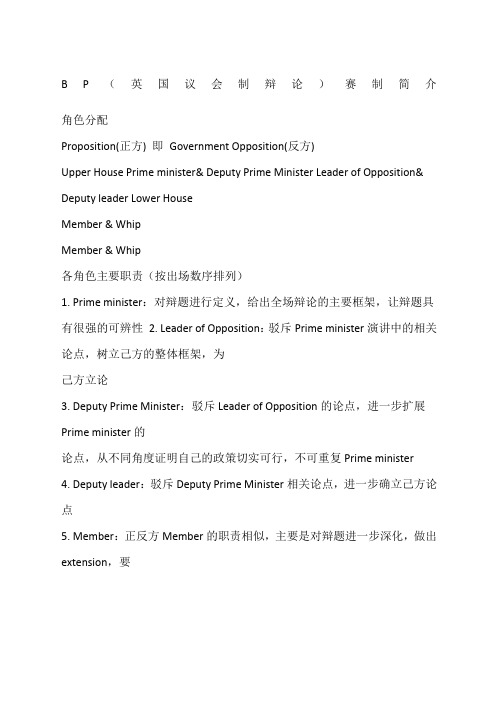
B P(英国议会制辩论)赛制简介角色分配Proposition(正方) 即Government Opposition(反方)Upper House Prime minister& Deputy Prime Minister Leader of Opposition& Deputy leader Lower HouseMember & WhipMember & Whip各角色主要职责(按出场数序排列)1. Prime minister:对辩题进行定义,给出全场辩论的主要框架,让辩题具有很强的可辨性2. Leader of Opposition:驳斥Prime minister演讲中的相关论点,树立己方的整体框架,为己方立论3. Deputy Prime Minister:驳斥Leader of Opposition的论点,进一步扩展Prime minister的论点,从不同角度证明自己的政策切实可行,不可重复Prime minister 4. Deputy leader:驳斥Deputy Prime Minister相关论点,进一步确立己方论点5. Member:正反方Member的职责相似,主要是对辩题进一步深化,做出extension,要求不可与upper house论点重复,要更换角度,深挖或者拓展论点,正方Member驳斥Deputy leader的论点,反方Member则要驳斥正方Member 的主要论点6. Whip:驳斥前一个人的论点,总结全场的Clashes,对己方的所有观点进行总结,但不可在此,再提出任何全新的观点(注:每人的演讲时间为7分钟).:全场比赛一共有四支队伍参赛,每支队伍2人,同一方的upper house 与lower house是合作与竞争的关系,既要击败对方,通过或者不通过相关政策,又要击败自己的队友,让评委对自己的队伍又更深刻的印象,获得全场比赛的胜利。
bp辩论规则介绍
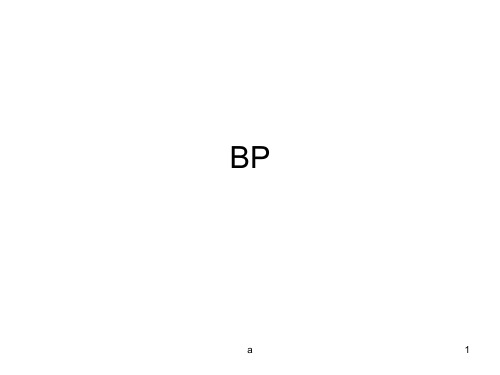
teams on each bench are on the same side, they
have to have different reasons for
supporting/opposing the motion. So for example, for
the Closing Government to come 1st in the debate, they
a
2
• There are 4 teams competing in each debate (2 teams on the government side, and 2 teams on the opposition)
• The motion to be debated and the positions is released only 15 minutes before the start of the debate
• - Closing Government (Member of Government & Government Whip)
• Opposition Bench:
• - Opening Opposition (Leader of Opposition & Deputy Leader of Opposition)
4th. The two teams on the Government Bench will
support the motion, and the two teams on the Opposition
Bench must oppose the motion. However, while the two
• - Closing Opposition (Member of Opposition & Opposition Whip)
BPdebate
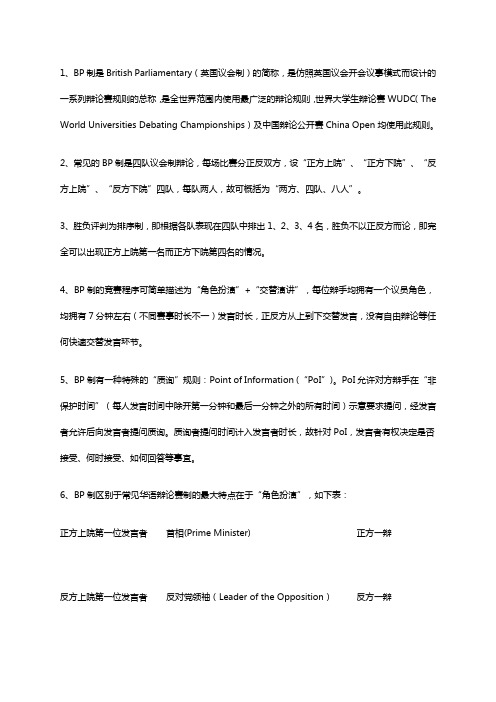
1、BP制是British Parliamentary(英国议会制)的简称,是仿照英国议会开会议事模式而设计的一系列辩论赛规则的总称,是全世界范围内使用最广泛的辩论规则,世界大学生辩论赛WUDC(The World Universities Debating Championships)及中国辩论公开赛China Open均使用此规则。
2、常见的BP制是四队议会制辩论,每场比赛分正反双方,设“正方上院”、“正方下院”、“反方上院”、“反方下院”四队,每队两人,故可概括为“两方、四队、八人”。
3、胜负评判为排序制,即根据各队表现在四队中排出1、2、3、4名,胜负不以正反方而论,即完全可以出现正方上院第一名而正方下院第四名的情况。
4、BP制的竞赛程序可简单描述为“角色扮演”+“交替演讲”,每位辩手均拥有一个议员角色,均拥有7分钟左右(不同赛事时长不一)发言时长,正反方从上到下交替发言,没有自由辩论等任何快速交替发言环节。
5、BP制有一种特殊的“质询”规则:Point of Information (“PoI”)。
PoI允许对方辩手在“非保护时间”(每人发言时间中除开第一分钟和最后一分钟之外的所有时间)示意要求提问,经发言者允许后向发言者提问质询。
质询者提问时间计入发言者时长,故针对PoI,发言者有权决定是否接受、何时接受、如何回答等事宜。
6、BP制区别于常见华语辩论赛制的最大特点在于“角色扮演”,如下表:正方上院第一位发言者首相(Prime Minister)正方一辩反方上院第一位发言者反对党领袖(Leader of the Opposition)反方一辩正方上院第二位发言者副首相(Deputy Prime Minister)正方二辩反对党副领袖(Deputy Leader of the反方上院第二位发言者反方二辩Opposition)正方下院第一位发言者政府阁员(Member of Government)正方三辩反方下院第一位发言者反对党阁员(Member of the Opposition)反方三辩正方下院第二位发言者政府党鞭(Government Whip)正方四辩反方下院第二位发言者反对党党鞭(Opposition Whip)反方四辩7、除一般的“立我方、批对方”的发言责任外,BP制中每个角色还有其独特的角色责任,对该责任的实现程度构成胜负评判的最大因素。
bp辩论规则介绍

Government) • 1st closing opposition (Member of Opposition) • 2nd closing government (Government Whip) • 2nd closing opposition (Opposition Whip)
Minister) • - Closing Government (Member of Government &
Government Whip) • Opposition Bench: • - Opening Opposition (Leader of Opposition & Deputy
Leader of Opposition) • - Closing Opposition (Member of Opposition &
BP
General Format and Rules
• World Universities Debating Championships --the Mt. Everest of Debating
• “World’s Style”, or British Parliamentary Style (“BP”)
• They may be delivered any time between the 1 minute and 6 minute bells.
• POIs may only be given to speakers on the other Bench. So if you are on the Opening Opposition, you can only ask POIs to the Opening Government and Closing Government but not to the Closing Opposition.
(完整word版)英国议会辩论制介绍
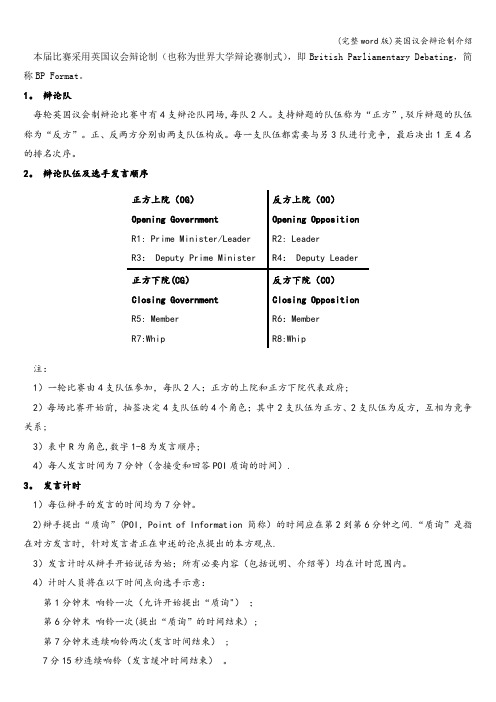
本届比赛采用英国议会辩论制(也称为世界大学辩论赛制式),即British Parliamentary Debating ,简称BP Format 。
1。
辩论队每轮英国议会制辩论比赛中有4支辩论队同场,每队2人。
支持辩题的队伍称为“正方”,驳斥辩题的队伍称为“反方”。
正、反两方分别由两支队伍构成。
每一支队伍都需要与另3队进行竞争,最后决出1至4名的排名次序。
2。
辩论队伍及选手发言顺序注:1)一轮比赛由4支队伍参加,每队2人;正方的上院和正方下院代表政府;2)每场比赛开始前,抽签决定4支队伍的4个角色;其中2支队伍为正方、2支队伍为反方,互相为竞争关系;3)表中R 为角色,数字1-8为发言顺序;4)每人发言时间为7分钟(含接受和回答POI 质询的时间).3。
发言计时1)每位辩手的发言的时间均为7分钟。
2)辩手提出“质询”(POI ,Point of Information 简称)的时间应在第2到第6分钟之间.“质询”是指在对方发言时,针对发言者正在申述的论点提出的本方观点.3)发言计时从辩手开始说话为始;所有必要内容(包括说明、介绍等)均在计时范围内。
4)计时人员将在以下时间点向选手示意:第1分钟末 响铃一次(允许开始提出“质询") ;第6分钟末 响铃一次(提出“质询”的时间结束) ;第7分钟末连续响铃两次(发言时间结束) ;7分15秒连续响铃(发言缓冲时间结束) 。
正方上院(OG ) Opening Government R1: Prime Minister/Leader R3: Deputy Prime Minister 反方上院(OO ) Opening Opposition R2: Leader R4: Deputy Leader 正方下院(CG ) Closing Government R5: Member R7:Whip 反方下院(CO ) Closing Opposition R6:Member R8:Whip注:在连续两次响铃结束后辩手有15秒“缓冲"时间,在这段时间内允许选手总结已出具论点;缓冲时间内,不允许出具新论据,否则所提新论据可被判为无效;“缓冲”时间后仍继续发言的辩手将被扣分。
- 1、下载文档前请自行甄别文档内容的完整性,平台不提供额外的编辑、内容补充、找答案等附加服务。
- 2、"仅部分预览"的文档,不可在线预览部分如存在完整性等问题,可反馈申请退款(可完整预览的文档不适用该条件!)。
- 3、如文档侵犯您的权益,请联系客服反馈,我们会尽快为您处理(人工客服工作时间:9:00-18:30)。
IDEA议会制四队辩论赛规则
The rules of IDEA Four-Team Parliamentary Debate are intended to closely follow those of the Worlds Universities Debating Championships (WUDC). They differ in some places to provide tournament directors options of deviating from the WUDC rules when they need to do so.
辩题将在一个中央地点向所有辩手公布。准备时间为十五至三十分钟,由大赛主办方规定。通常,辩手在准备时间内可以与自己的搭档讨论。某些情况下,主办方也允许辩手与教练或带队老师讨论。此间,辩手可以参阅任何纸质资料。世界大专辩论赛允许辩手在辩论过程中使用任何纸质材料;而其他比赛仅允许辩手在准备时间内使用事前准备好的资料。准备期间,通常可以使用电子词典,但禁止使用其它一切电子设备。
Ordinarily, motions are announced shortly before each debate begins. A different motion will be used for each debate and will be presented to the debaters at a specified time, usually fifteen to thirty minutes prior to the debate. In some situations general topic areas (for example “environment” or “international relations”) or even specific motions themselves may be announced prior to the tournament.
IDEA议会制四队辩论赛谨遵循世界大专辩论赛(WUDC)的规则。两者略有不同之处,以便比赛主办方根据需要灵活操作。
The Teams and Motions
The teams supporting the motion in the IDEA Four-Team Parliamentary Debate are referred to as the "Proposition." The teams arguing against the motion are known as the "Opposition" teams.
参赛队伍及辩题
在IDEA议会制四队辩论赛中,支持辩题的队伍为“正方”,反对ቤተ መጻሕፍቲ ባይዱ题的队伍为“反方”。
“辩题”,即辩论所围绕展开的议题。辩题将辩手分为正反两方,且双方均有合理辩论的余地。
通常,辩题于各轮比赛开始前十五或三十分钟公布;每轮辩题均不相同。有时,辩题范围(如“环境问题”,“国际关系”等)甚至辩题本身也会在大赛开始前公布。
A “motion” is the statement around which the debate takes place. The motion divides the ground in the debate between the Proposition and Opposition teams and should allow for reasonable arguments both for and against.
The motion will be announced to all debaters simultaneously in a central location. Preparation time will be between fifteen and thirty minutes, at the discretion of the tournament director. In general, debaters may confer with their debate partner during preparation time. In some cases, a Tournament Director may allow debaters to confer with their coach or tutor. During this time the debaters may consult any written materials. The rules of the World Universities Debating Championships permit debaters to access any written material during the debate; other tournaments permit the debaters to access only the notes they made in preparation time. Electronic retrieval devices typically are not allowed during preparation, though electronic dictionaries typically are permitted for second-language speakers.
The Debate Format
Four teams participate in each debate: two on the Proposition and two on the Opposition. Each team works independently to either support or oppose the motion. Each team is made up of two speakers; each speaker will present a speech not to exceed 7 minutes in the order prescribed below.
